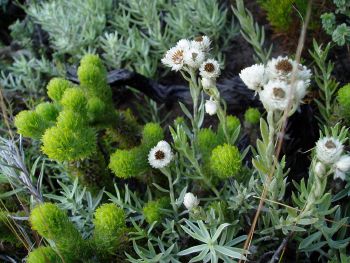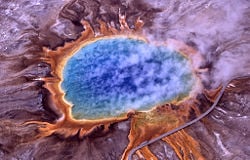Life
A difficult term to define, life can be considered the characteristic state of living organisms and individual cells, or that quality or property that distinguishes living organisms from dead organisms and inanimate objects.
Although universal consensus on a definition is lacking, biological properties common to the known organisms found on Earth (plants, animals, fungi, protists, archaea, and bacteria) are that they are carbon-and-water-based, are cellular with complex organization, use energy and undergo metabolism, possess a capacity to grow, maintain homeostasis, respond to stimuli, reproduce, and have various adaptations to the environment.
Not every definition of life considers all of these properties to be essential. For example, the capacity for descent with modification is often taken as the essential property of life. This definition notably includes viruses, which do not qualify under narrower definitions as they are acellular and do not metabolize. Broader definitions of life may also include theoretical non-carbon-based life.
Beyond the biological manifestations of matter, some philosophical perspectives, notably the Aristotelian theory of the soul and modern vitalism, add that living organisms possess an inner aspect or character that confers the quality of life (below). They do not agree with a modern biological orientation that explains the phenomena of life only in terms of external principles of chemistry and physics.
Although it cannot be pinpointed exactly, evidence suggests that life on Earth has existed for about 3.7 billion years.[1]
Biological characteristics of life
Living organisms share many universal characteristics, including that they are composed of cells; pass on their heredity using a nearly universal genetic code; need energy from the environment to exist, grow, and reproduce; and maintain their internal environment; among others. These are the common set of characteristics identified by biologists that distinguish living organisms from nonliving things. Non-living entities may exhibit some of these characteristics, but not all of them.
- Cells. With the exception of viruses, all organisms consist of cells. A cell is the basic unit of life, being the smallest unit that can carry on all the processes of life, including maintenance, growth, and even self-repair. Some simple life forms, such as the paramecium, consist of a single cell throughout their life cycle and are called unicellular organisms. Multicellular organisms, such as a whale or tree, may have trillions of cells, and have differentiated cells that perform specialized functions.
- Carbon-based biochemistry. Living organisms are characterized by a common carbon-based biochemistry. All organisms pass on their heredity via the genetic material that is based upon nucleic acids, such as DNA, using a nearly universal genetic code. Every cell, no matter how simple or complex, utilizes nucleic acids for transmitting and storing the information needed for manufacturing proteins.
- Complex organization. Living organisms are complex and organized, both at the molecular and cellular levels. The energy and materials from the environment are organized, such as the internal structure of a cell, or the organization of multicellular organisms into tissues, organs, and systems. Nonliving things may be complex, but the organization in living things is much more complex. In essence, living organisms, utilizing energy from without, reverse entropy. Whereas the general tendency is for non-living entities to lose energy and tend toward disorder, or to exist in order only due to such external forces as gravitation or electro-magnetic forces, living organisms process energy and use it to exist in states of complex order.
- Energy and metabolism. Every living being needs energy from the environment in order to exist, grow, and reproduce. Living things require energy to maintain internal organization (homeostasis) and to produce the other phenomena associated with life, such as movement and work. The sun is the main source of energy and is captured through a process of photosynthesis, a process by which plants, algae, and some bacteria harness the energy of sunlight to produce food. Ultimately, nearly all living things depend on energy produced from photosynthesis for their nourishment, making it vital to life on Earth. There are also some bacteria that utilize the oxidation of inorganic compounds such as hydrogen sulfide or ferrous iron as an energy source. An organism that produces organic compounds from carbon dioxide as a carbon source, using either light or reactions of inorganic chemical compounds as a source of energy, is called an autotroph. Other organisms do not make their own food but depend directly or indirectly on autotrophs for their food. These are called heterotrophs. Metabolism is the biochemical modification of chemical compounds, including converting nonliving material into complex organic molecules (synthesis) and decomposing organic matter (catalysis), yielding energy-carrying molecules and essential building-block molecules.
- Development and growth. Living things grow and develop as they age. This involves maintenance of a higher rate of synthesis than catalysis, with growth of the organism taking place through cell enlargement and cell division. A growing organism increases in size in all of its parts, rather than simply accumulating matter. In most metazoan organisms, the basic steps of the early embryo development share similar morphological stages and include similar genes.
- Homeostasis: All living organisms, whether unicellular or multicellular, exhibit homeostasis. Homeostasis is the property of an open system to regulate its internal environment so as to maintain a stable condition. Homeostasis can manifest itself at the cellular level through the maintenance of a stable internal acidity (pH); at the organismal level, warm-blooded animals maintain a constant internal body temperature; and at the level of the ecosystem, for example when atmospheric carbon dioxide levels rise, plants are theoretically able to grow healthier and thus remove more carbon dioxide from the atmosphere. Tissues and organs can also maintain homeostasis.
- Response to stimuli. All living organisms respond to the environment. A response to stimuli can take many forms, from the contraction of a unicellular organism when touched to complex reactions involving all the senses of higher animals. A response is often expressed by motion, for example, the leaves of a plant turning toward the sun or an animal chasing its prey. A cockroach may respond to light by running for a dark place. When there is a complex set of response, it is called a behavior. For example, the migration of salmon is a behavioral response.
- Adaptation. Living organisms have characteristics that give them a survival/reproductive advantage in an environment; that is, they have adaptations to the environment. Living organisms show variability in these adaptations, allowing the species to continue in a fluctuating or changing environment.
- Reproduction. Reproduction is the ability to produce new organisms. Reproduction can be the division of one cell to form two new cells. Usually the term is applied to the production of a new individual (either asexually, from a single parent organism, or sexually, from at least two differing parent organisms), although strictly speaking it also describes the production of new cells in the process of growth. Sexual reproduction is a trait that is almost universal, if not universal, among living beings. Asexual reproduction is not uncommon. In fact, it is widespread among fungi and bacteria, many insects reproduce in this manner, and some reptiles and amphibians. Nonetheless, sexual reproduction is also seen in these same organisms, including in bacteria which will exchange genetic material between donors (+ mating type) and recipients (- mating type). Evolutionary biologist and geneticist John Maynard Smith maintained that the perceived advantage for an individual organism to pass only its own entire genome to its offspring is so great that there must an advantage by at least a factor of two to explain why nearly all animal species maintain a male sex.
It is important to note that reproduction as a characteristic applies primarily at the level of species, so even though many individuals of any given species do not reproduce, possibly because they belong to specialized sterile castes (such as ant workers) or are sterile for other reasons, including age or disease, these are still considered forms of life. Likewise one could say that the property of life is inherited; hence, sterile hybrid species such as the mule are considered life although not themselves capable of reproduction. For similar reasons, viruses and aberrant prion proteins are often considered replicators rather than forms of life, a distinction warranted because they cannot reproduce without very specialized substrates such as host cells or proteins, respectively. However, most forms of life rely on foods produced by other species, or at least the specific chemistry of Earth's environment.
Philosophical characteristic of life
In addition to the above, generally recognized biological characteristics, some philosophers recognize another quality that comprises living organisms.
- 10. Life-factor. This additional characteristic is an immaterial, inner aspect that distinguishes living organisms, such as plants and animals, from inanimate objects, such as atoms, molecules, and minerals. This quality or characteristic of "life" is an invisible, non-material force that underlies the physical, and Aristotle calls it the "soul" (psyche). According to Aristotle, every existing thing is composite of "form" (its essence or whatness) and "matter" (the material stuff it is made of), and form and matter are inseparable from each other (hylomorphism). The "form" of a living thing, whether it is a plant or an animal, is the soul, while its "matter" is the body. Life is none other than the soul of a living thing, which is the ability to engage, through the body, in the activities that are characteristic of living things in the worldâactivities such as self-nourishment, growth, reproduction, locomotion, perception, and intellect. While the plant soul can only engage in self-nourishment, growth, and reproduction, the animal soul can engage in locomotion and perception as well as in the activities of the plant soul. The human soul can engage not only in all these activities but also in intellect.
Aristotle, perhaps the very first biologist in the West, understands the soul (life) to be always inseparable from the body, and this notion of the soul is very different from our modern understanding of it as something immortal beyond physical life. If this Aristotelian view is applied, the DNA and proteins of a cell may only be the external or physical aspect of lifeâthe base of life or the part that carries life, and there is an immaterial "life field" that guides the DNA. By analogy, the chemistry and structures of a cell is like a radio while life is like the radio waves that give meaning to its sound; or the structures of a cell forms the computer while the life-force is like the software that runs on the computer to do meaningful tasks. The life-factor has the quality of mind; it carries the qualities of consciousness.
In process philosophy, the internal aspect of living organisms is regarded as a subset of the two qualities that living organisms share with all existent beings, the quality of dual characteristics or polarity. Alfred North Whitehead (1861-1947) calls it the "dipolarity" of reality, which means that every actual entity in the universe has two distinguishable yet inseparable poles: mental and physical. Both Aristotle and Whitehead find the dual characteristics of form and matter (Aristotle) or of mental and physical poles (Whitehead) in nonliving beings as well. For them, however, living beings have a higher degree of the development of the internal than nonliving beings, thus having activities of life.
Another school relevant to this discussion is vitalism, according to which living organisms possess a non-physical inner force such as the "entelechy" of Hans Driesch (1867â1941) and the "Ă©lan vital" of Henri Bergson (1874-1948), to which the biological activities of living organisms can be ascribed. Vitalism is opposed to biological mechanism which maintains that phenomena of life can be explained exclusively in terms of chemistry and physics that deal with matter.
Origin of life
There is no truly "standard" model for the origin of life, but most currently accepted scientific models build in one way or another on the following discoveries, which are listed roughly in order of postulated emergence:
- Plausible pre-biotic conditions result in the creation of the basic small molecules of life.
- Phospholipids spontaneously form lipid bilayers, the basic structure of a cell membrane.
- Procedures for producing random RNA molecules can produce ribozymes, which are able to produce more of themselves under very specific conditions.
There are many different hypotheses regarding the path that might have been taken from simple organic molecules to protocells and metabolism. Many models fall into the "genes-first" category or the "metabolism-first" category, but a recent trend is the emergence of hybrid models that do not fit into either of these categories.
From a philosophical or religious perspective, the external manifestation of the development of life was guided at every stage of the process by the internal life-force, and ultimately by the Supreme Being or Creator.
The possibility of extraterrestrial life
- Main articles: Extraterrestrial life
Earth is the only planet in the universe known to harbor life. The Drake equation has been used to estimate the probability of life elsewhere, but scientists disagree on many of the values of variables in this equation. Depending on those values, the equation may either suggest that life arises frequently or infrequently.
Notes
- â University of California Museum of Paleontology, "History of life through time.", Regents of the University of California, 2008. Retrieved February 14, 2008.
See also
ReferencesISBN links support NWE through referral fees
- Durrant, Michael, ed. 1993. Aristotle's De Anima in Focus. London: Routledge. ISBN 0415053404
- Margulis, L., and D. Sagan. 1995. What Is Life? Simon & Schuster. ISBN 0684810875
- Schrodinger, E. 2000. What is Life? Cambridge University Press. ISBN 0521427088
- Towle, A. 1989. Modern Biology. Austin, TX: Holt, Rinehart and Winston. ISBN 0030139198
Credits
New World Encyclopedia writers and editors rewrote and completed the Wikipedia article in accordance with New World Encyclopedia standards. This article abides by terms of the Creative Commons CC-by-sa 3.0 License (CC-by-sa), which may be used and disseminated with proper attribution. Credit is due under the terms of this license that can reference both the New World Encyclopedia contributors and the selfless volunteer contributors of the Wikimedia Foundation. To cite this article click here for a list of acceptable citing formats.The history of earlier contributions by wikipedians is accessible to researchers here:
The history of this article since it was imported to New World Encyclopedia:
Note: Some restrictions may apply to use of individual images which are separately licensed.


